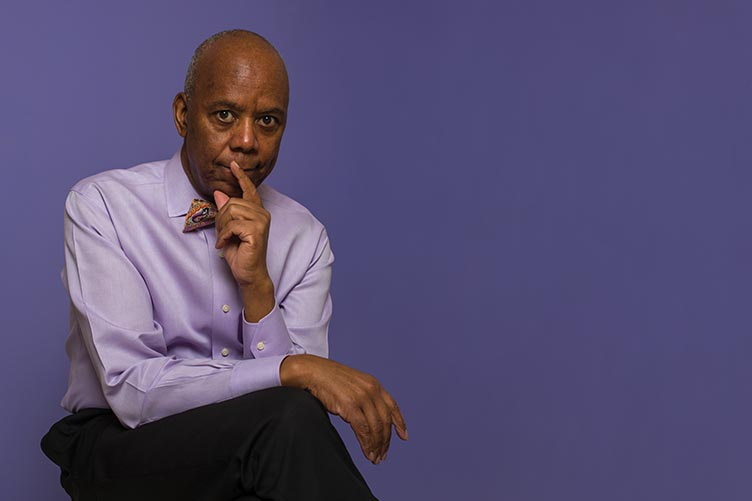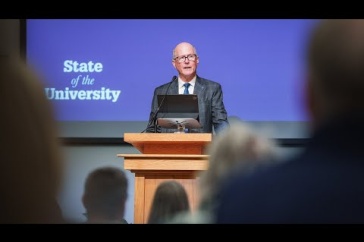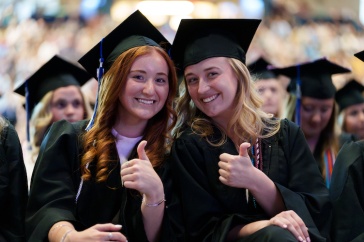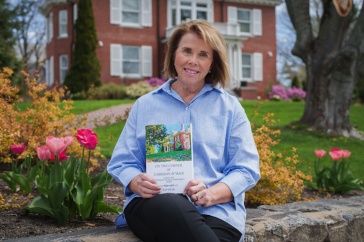
It’s raining sideways as a Nor’easter roars across the New Hampshire Seacoast. But inside the tidy Portsmouth home of Richard Haynes, all is calm.
Smartly attired in a crisp shirt and bowtie — he’s spent the morning on campus with prospective Wildcats — Haynes, UNH’s associate director of admissions for diversity and a 2018 winner of the Presidential Award of Excellence, sits at a yellow table in his bright dining room. He’s the embodiment of hope and optimism when racial and ethnic enmity seem to be increasing around the world. He’s animated as he discusses his art, working with students, his many community projects, and life. “This is my art gallery,” he says, glancing around the room. He’s literally surrounded by his work; his photographs and large, contemporary drawings (he works primarily in wax crayon, a technique called caran d’ache) hang on nearly every wall of his rainbow-hued home. Each room is painted in bold colors — purple, orange, green, yellow — vibrant backdrops for his art.
Haynes, who is black, uses his color-saturated, semi-abstract drawings to share his personal history and communicate messages about love, racial unity and building community: grownups of different races sitting on a curb, chatting; children of various ethnicities playing games together; women gossiping over tea; slaves moving through the Underground Railroad; blues and jazz music.
An artist his entire life, he describes himself as a maker and keeper of cultural mores. “Artists are the ones paying attention to what’s happening around them,” he says. “We’re the cultural keepers and cultural makers.” As Haynes speaks about his own challenges and those faced by the students he meets, his empathy and love of humanity are palpable. Hope, love, spirituality and an education are key to surviving life’s challenges, he believes. “If you really embrace those things, you can become the best you so that you are the best for others,” he says. Haynes wants nothing less than to change the world. “I want you to look at my art or hear one of my presentations and say, ‘you’ve inspired me’,” Haynes says. “I want you to look deeper at the world, and then make a change in your own life.”

FINDING HOPE
Haynes’ positivity didn’t come without struggle. The middle child in a family of seven, he spent his early years in segre- gated Charleston, South Carolina, where his parents picked cotton in summer and worked as “the help” — servants — the rest of the year and racism was a daily fact of life. In 1957, the family moved to Harlem, part of the Great Migration of African American families searching for new jobs and oppor- tunities, but the reality was the extended family living in crowded, sometimes rat-in- fested, apartments, passing heroin addicts on the street corner, and Haynes enduring regular beatings for his southern drawl. After one such beating, Haynes asked his grand- mother a bewildered question: This was better? “’Better,’” he recalls her responding, “Yes. But only if you make it better.’” Haynes got a taste of “better” at the age of 9, when he saw the movie “Ben Hur.” Fascinated by the color and the action, he knew then that he wanted to be a photographer. His mother gave him a Brownie camera, and he was off, shooting photos whenever he could. In middle school, “better” got a boost from art teacher Miriam Powers, who suggested that Haynes com- bine his photography skills with his artistic ability. On weekends the duo explored New York City’s world-famous art museums, including the Metropolitan Museum of Art and the Whitney Museum of American Art. He was hooked. “She told me my ability to make photographs would strengthen my artistic ability,” he says. “I use photographs to create my paintings. When I paint, I try to capture moments, very much like photography.”
His artistic talent aside, Haynes was an indifferent high school student, and with the Vietnam War approaching, he was drafted shortly after graduation, spending four years as an Air Force dental technician both in Guam and at New Hampshire’s Pease Air Force Base. Returning home in 1972, he was met at the airport by Powers, who announced, “It’s time to finish your educa- tion.” Haynes attended community college, then went on to earn a bachelor’s degree in fine art from Lehman College (where he also met his wife, Marita) and a master’s degree in photography from Pratt Institute. He established a successful career as a photographer for several of the world’s largest book publishers as well as CBS Publishing, and he and Marita welcomed three children.

Then, in the late 1980s, Haynes moved his family to Portsmouth — a city he’d discovered during his time in the military at Pease. They loved the area, but despite his commercial success in New York City, Haynes couldn’t find paying work. “I didn’t know if I couldn’t find a job because I was a man of color,” he says, but he soon found himself struggling to hold on to a piece of wisdom his mother had given him years earlier: “She told me, ‘don’t allow anyone’s opinion of you to become your reality.’” A year passed, and then two more. Haynes borrowed from his parents to keep his family afloat and plunged into despair.
With his trademark candor, Haynes says he was making plans to end his life when a woman he’d never met before — Elise Gray, a local minister — approached him at a wedding, tapped him on the shoulder and told him he needed to come to her church the following day. Though he was skeptical, he complied, slipping in late to take a seat in the back row. “I figured that way I could leave easily, but every passage she read, every hymn we sang, spoke to me that day,” he recalls. Then and there, he realized he needed to tell his own story and to will into being the reality he wanted for himself and for his family. He picked up his pencils and wax crayons and started drawing.
Soon, what began as a way for Haynes to work through his emotions became a continuous form of self-expression and observation. His art is vibrant and multi-layered with meaning; using bold colors is intentional.
“Colors give hope, they’re the celebration of life,” he says. “Bright, bold colors help us stay hopeful in the middle of a storm.”
Inexorably, Haynes emerged from his own storm. Photo assignments started coming in — first from Pearson Education in Boston and soon from other clients. He joined the faculty of McIntosh College in Dover as a photography and fine art professor and began reading admissions applications part-time for UNH. In 2005, he was named the university’s associate director of admissions for diversity, recruiting and mentoring students of color from across New England. And he kept creating the world he wanted to see through his art, including exhibits in Portsmouth and Manchester and numerous community mural projects at UNH and across the state.
Last summer, as part of an artist-in-residency at Portsmouth’s Gov. John Langdon House, Haynes brought to light the virtually unknown story of Cyrus Bruce, a free black man employed by New Hampshire Gov. John Langdon in the late 18th century. The residency coincided with an exhibition of Haynes’ work, “A Life in Color: Two Cultural Makers, Centuries Apart.” Delving into what little research existed about Bruce, the artist discovered the servant was renowned locally for his colorful attire. “He was one of the best-dressed men in Portsmouth,” Haynes says. Haynes created three different studies of Bruce for his portrait, and members of Historic New England and the Black Heritage Trail, organizations sponsoring his residency, voted on which color to use for Bruce’s waistcoat. The final portrait, now part of the Langdon House and Historic New England’s permanent collection, shows Bruce as he may have appeared, greeting visitors at the home’s open door, resplendent in purple. Bruce’s face, like all of the faces in Haynes’ portraits, is featureless because, Haynes notes, “We don’t give a lot of attention to individuals of color.” His mother’s advice is a mantra he repeats through his art.
“Part of creating Cyrus Bruce’s portrait was to convey the message that, no matter how difficult your life is, don’t allow anyone’s opinion of you to become your reality. In the midst of his servitude, Bruce had pride and dignity,” he says.

DEFINING THE PATH TO FREEDOM AND OPPORTUNITY
Education, Haynes believes, is another medium for creating the world you want to live in, and as an admissions officer, he commands an auditorium full of fidget- ing high school students as boldly as he paints. He wants students to understand that they’re in charge of their lives. “I want students — all students, not just students of color or first-generation students — to believe in themselves,” he says. “I tell them, ‘You are who you are because of what you put in your mind.’"
Dressed in a suit and his trademark bowtie, Haynes speaks to an estimated 2-3,000 middle and high school students annually in a territory that encompasses far western Massachusetts and inside Boston’s Route 128 corridor. His presentations usually include a dramatic retelling of his childhood in South Carolina and Harlem. Striding back and forth, his voice rising and falling like a minister speaking to his congregation, Haynes captivates his young audiences. He tells them that education offers opportunity and that they’re in charge of the college admissions process, using his own high school experience as a cautionary tale. “Messing up in high school made me an exemplary admissions officer,” he says. “I tell students, ‘You’re just as good as anyone else. You’re all born to win, but you must plan to win, prepare to win and never expect not to win.”
Students respond to Haynes’ message. Xiomara Albán ’10, associate director of admissions at Elms College in Chicopee, Massachusetts, remembers Haynes visiting her Springfield high school when she was 16. “I’d thought about going to college, but meeting Richard really put it in perspective for me,” Albán says. “He was the only person of color I met during the admissions process. As a Latin American woman, this was powerful. He made attending UNH realistic for me.”
Throughout her Wildcat experience and as a student leader, Albán found Haynes a caring mentor who checked in regularly to see how she was doing, socially and academically. After graduation, she worked for Haynes as a UNH admissions officer.

“Education equals freedom and opportunity — I learned that from Richard and used this to motivate myself through my own life experiences,” says Albán. “I’ve been able to share the value of education as a professional with other students. Richard is a continuous reminder of compassion and dedication towards others. He genuinely wants us to become better versions of ourselves.”
Yamilex Bencosme ’16, who met Haynes during her senior year of high school, considers him a lifelong mentor. A Spanish-speaker, Bencosme was the first in her family to attend college. “I was walking through our high school college fair, and I was completely overwhelmed,” she remembers. “Richard looked at me and said, ‘Come over here.’ We chatted, and he said, ‘You’re a bilingual Spanish speaker, do you know how far you can go in this world?’ I went to UNH because of Richard.” Bencosme went on to become a UNH diversity ambassador, work- ing under Haynes to recruit students of color, as well as a McNair Scholar.
Rob McGann, UNH’s director of admissions, says Haynes’ efforts are helping boost enrollment at UNH among students of color, who account for 10 percent of the first-year population in 2018-2019. McGann believes Haynes’ strength is building relationships. “He nurtures personal relationships with students and helps them feel confident about the admissions process and the possibilities of an education at UNH,” McGann says. “He’s intensely focused on helping students see the possibilities that their lives hold for them when enhanced by a UNH education.”
MAKING IT BETTER
Another way Haynes brings together his work at UNH and his art: community-focused art projects aimed at fostering racial unity. Last year, he co-created “Culture Keepers, Culture Makers” with UNH col- leagues Kristen Butterfield ’08 and Sylvia Foster, education program coordinator for the university’s Office of Community, Equity and Diversity. At workshops in Exeter and Durham, Haynes asked participants, “What do you want people to discover from your drawings? How will you show them what it was like to be living in a time when we were emerging into a world without racism?” Based on the group’s responses, participants created original art work depicting their views of that new world, which were featured in an exhibit that traveled to libraries around the New Hampshire Seacoast throughout the summer.
“Richard gave us the gift of working from his center — his desire to make the world better for his grandchildren,” Foster says. “He not only opens people’s minds to see injustices, he inspires people to imagine what equitable and just systems can look like.”
Haynes’ current passion project is a tribute to Marita, his wife of 46 years, who passed away in November 2017. “Whispering Quilts” is both an art book and a story about a family’s journey out of slavery, aided by coded pictures found in quilts. Marita, who worked part-time for UNH admissions, conceived the story and a friend finished the manuscript after she succumbed to pancreatic cancer. The limited-edition portfolio book — only 20 copies have been published — is illustrated with numbered giclée prints of Haynes’ work, a colorful interpretation of quilting squares superimposed on semi-abstract images of slaves escaping the South via the Underground Railroad.

Later this year, still another project of Haynes’ will be on exhibit at Boston’s St. Botolph Club. Called “Love,” it features a series of images — clasped hands, the dove of peace, human bodies that form the tree of life — all framed within circles that represent the universality of his message. “After telling my own story all these years, I decided it was time to tell a world story,” Haynes explains. The images are circular both to represent the globe and to illustrate the unifying power of love. “We’re putting everyone in boxes right now,” he says. “That’s what’s troubling us now in the world. Love doesn’t put you in a box, love breaks you out of the box.”
Love. Hope. Optimism. Haynes says that it’s because of all the adversity he has faced — not in spite of it — that these are his enduring message. “Struggles are good for you,” he says. “They bring about perseverance. Endurance. Character. And at the end, you lack nothing.”
-
Written By:
Debbie Kane | Freelance Writer

















































